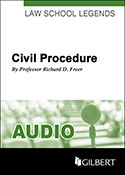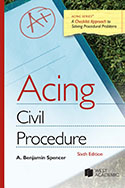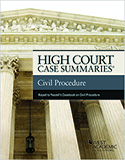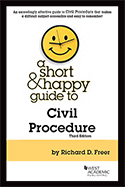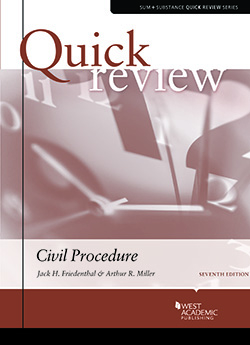
Sum and Substance Quick Review on Civil Procedure
Authors:
Miller, Arthur R. / Friedenthal, Jack H.
Edition:
7th
Copyright Date:
2008
23 chapters
have results for civil procedure
Preface 4 results
- These materials place some emphasis on practice in the federal courts, particularly the Federal Rules of Civil Procedure. This is because these Rules have served as a model for procedural reform in a large majority of the states and provide the background for most civil procedure courses. State practice is not slighted, however, and comparisons between different approaches are drawn throughout this work.
- purpose is to help students learn and understand the materials encompassed in civil procedure courses. There are no footnotes. Case citations are kept to a minimum to preserve a comprehensible flow and to avoid interminable scholastic qualifications. Of course, in order to facilitate a succinct treatment of the basic issue of civil procedure it has been necessary to generalize to a great degree. Although we have sought to limit out generalizations to well accepted controlling principles, the reader should recognize that this work is not designed for the daily practice of law in which exceptions to generalizations and exceptions to the exceptions frequently dominate a practical problem. Our ultimate goal has not been to cover American civil litigation and trial practice in all their intricacy, but to prepare a basic student text on a complex topic whose application is subject to many refined levels of sophistication.
- This book is designed to help you understand the basic concepts and principles of civil procedure. It often is difficult to understand a textual discussion of a procedure problem in the abstract; consequently, we have illustrated numerous principles with hypothetical examples to insure that the operation of each aspect of the litigation process is seen against a concrete factual background.
- designed as a full service teaching tool to allow you to maximize your comprehension of civil procedure.
- Open Chapter
Chapter I. Introduction and Historical Background 10 results (showing 5 best matches)
- Civil procedure courses generally encompass the process, in civil as opposed to criminal cases, of selecting a proper court in which a case can be heard, identifying the nature of the grievances and the defenses thereto, determining the proper parties, preparing for trial, deciding the case with or without trial (and, in the event of trial, with or without a jury), challenging the decision on appeal, enforcing a final determination, and giving appropriate effect to a judgment in subsequent litigation. This book will deal with all of these subjects in the same chronological order in which they occur in litigation.
- A. SCOPE OF CIVIL PROCEDURE. [§1.0000]
- a. Importance of the Federal Rules of Civil Procedure. [§1.1100]
- Pursuant to its rulemaking powers [28 USC 2072], the United States Supreme Court in 1938 promulgated a comprehensive set of Federal Rules of Civil Procedure for use in the Federal Courts, encompassing
- In any jurisdiction the ultimate source of procedural regulation is the local constitution. Although constitutions typically provide some specific direction with respect to the nature of a jurisdiction’s courts and their powers [see, e.g., United States Constitution, Article III], and the right to trial by jury [see, e.g., United States Constitution, Seventh Amendment], very little else is set out in detail. Usually the legislature, operating under a general power to establish a judicial system, enacts a Civil Procedure Code. In 1934 Congress delegated much of its procedure-making power to the United States Supreme Court, and many state legislatures have since granted similar powers to their highest courts. In general, these delegations have been very successful. Judges seem able to make important procedural changes when legislators, who are directly subject to political pressures from interest groups and often have little political incentive to deal with the subject, cannot do so.
- Open Chapter
Chapter XVII. Securing and Enforcing Judgments and Orders 18 results (showing 5 best matches)
- b. Procedure for Civil Arrest. [§17.1420]
- A civil contempt citation against a party to the original action is interlocutory; thus, in a final judgment rule jurisdiction [see ], an appeal must await the rendition of a final judgment. If, however, the civil contemnor is a non-party, the appeal may be taken immediately. When the contempt order is criminal, or both civil and criminal, the order is final and appeal is available at once.
- If the primary purpose of punishing the contemnor is to vindicate the authority of the judicial system, the contempt is criminal. On the other hand, if the ultimate objective of the sanction is to give the successful litigant the benefits of the order that is being disobeyed, the contempt is civil. In either case, the penalty may be a fine or imprisonment or both. However, a person may terminate incarceration for civil contempt simply by complying with the court’s order. In that sense the contemnor is said to have the keys to the jailhouse door. But since the objective of criminal contempt is primarily punitive, a criminal contemnor usually is incarcerated for a fixed period. As long as the contemnor is not prejudiced, civil and criminal proceedings may proceed simultaneously.
- 4. Civil Arrest. [§17.1400]
- Historically, civil arrest involved taking a defendant who was likely to leave the jurisdiction into custody and keeping him physically restrained until either bail was posted or judgment was rendered. The abuses that accompanied this practice led many legislatures either to prohibit or to restrict the availability of this provisional remedy. For example, New York first limited civil arrest to actions based on fraud, deceit, or conversion. Even in those cases the remedy could be used only when the person to be arrested was not a parent or guardian or a dependent child or incompetent. Subsequently, New York eliminated the remedy completely.
- Open Chapter
Title Page 1 result
Index 17 results (showing 5 best matches)
Table of Contents 12 results (showing 5 best matches)
Chapter II. Selecting a Proper Court 14 results (showing 5 best matches)
- The remaining material in this chapter will focus on the subject matter jurisdiction and venue principles governing the United States district courts. The reason for this is that the federal scheme, which, given the character of the federal courts, is a national scheme, provides a useful and particularly relevant model for exploring problems of subject matter jurisdiction, venue, and federalism. Not surprisingly, therefore, many first year teachers of civil procedure and many procedure casebooks focus on the federal scene in developing this material. It should be understood, however, that the analysis that follows is designed for procedure courses, not for more advanced courses in federal courts or federal jurisdiction.
- (1926)]. A much greater expansion of ancillary jurisdiction came in 1938 with the adoption of the Federal Rules of Civil Procedure. As discussed below [see
- Some of the better known enactments are: the patent, copyright, antitrust, securities, civil rights, and various interstate commerce acts.
- Cases may be removed only from a state to a federal court. There is no procedure for sending a case instituted in a federal court to a state court or from a court in one state to a court in another.
- 7. Procedure for Seeking Removal. [§2.6700]
- Open Chapter
Chapter IX. Discovery 3 results
- Discovery refers to those procedural devices by which a party or potential party to a lawsuit obtains information relating to the case. The need for some court procedure to allow a party to obtain and preserve evidence was recognized in early English equity practice. Not until the promulgation of the Federal Rules of Civil Procedure in 1938, however, did pretrial discovery, as we know it today, become a vital part of the litigation process. And indeed, the Federal Rules revolutionized trial practice in the United States. Almost every state has adopted a set of regulations for widespread discovery modeled after the Federal Rules.
- than other devices, they have few of the advantages of an oral deposition since there is usually no attorney present during the procedure to observe the demeanor of the witness. As a result, written depositions are used infrequently.
- called to testify at trial. It also permits the attorney to pin down the witness as to essential factual details that are relevant to the case. Most importantly, the attorney is able to “follow up” on the witness’ answers, and pursue different lines of interrogation than originally contemplated. None of this would be possible if a witness merely responded to questions while at home or in his or her office, with the benefit of counsel, and with no direct confrontation by the deposing attorney. Unfortunately, the extremely high costs of this procedure often prevent it from being utilized.
- Open Chapter
Chapter VIII. Class Actions, Intervention, and Interpleader 17 results (showing 5 best matches)
- Class action practice differs from state to state, with some states having extremely limited rules. Probably the most liberal approach to class action litigation is found in Section 382 of the California Code of Civil Procedure, which provides only that “when the question is one of a common or general interest, of many persons, or when the parties are numerous, and it is impracticable to bring them all before the court, one or more may sue or defend for the benefit of all.” The most striking difference between this provision and Federal Rule 23 is that California courts are not required to differentiate among different types of class actions as federal courts are required to do [see
- For more than four decades the class action has been an extremely popular and controversial procedure, particularly in the federal courts. It has been used extensively in antitrust, securities, products, environmental, discrimination, and welfare benefits litigation. The enormous increase in class action activity often is attributed to the liberalizing revision of Federal Rule 23 in 1966. However, the trend probably also reflects changes in the substantive law in the areas mentioned above, increased attention to social action litigation, and the attractiveness of class action attorney’s fee awards. Whatever the cause, the class action has imposed burdens on the judiciary and corporate defendants and has led some to challenge it as a “Frankenstein monster.” On the other hand, the procedure may represent the only viable method for people with small claims to vindicate their rights or with civil rights claims to litigate important social issues. Supreme Court decisions [see
- procedure). Although these two procedures embody the basic principles of interpleader discussed above, there are some important differences between them.
- (1997). New proposals that were adopted in 2003 increased the court’s control over the class action process regarding notice, the appointment of class counsel, and attorneys fees. The changes to the Federal Rules of Civil Procedure adopted in 2007 contained only stylistic changes to Rule 23.
- Along with the expansion of joinder of parties and joinder of claims [see Chapters Six and Seven], procedural systems have developed a number of special devices for the handling of litigation involving multiple parties. This chapter discusses the three most significant of these procedures—class actions, intervention, and interpleader.
- Open Chapter
Chapter IV. Determining the Governing Law 13 results (showing 5 best matches)
- approach also created concern about the viability of the Federal Rules of Civil Procedure because almost any procedural rule might affect the outcome of a case if used in lieu of a different state practice. The specter of this result caused many commentators to criticize
- In a personal injury diversity action in a federal court in State X, D seeks a physical examination of P under Federal Rule 35. P objects on the ground that physical examinations are not permitted in civil actions in the courts of State X and that Federal Rule 35 is invalid because it exceeds the Supreme Court’s rule-making power. The physical examination will be ordered because Rule 35 is a valid regulation of procedure and
- A final option for a federal court faced with a difficult issue of state law is to certify a question to the applicable state high court. The certification procedure enables a federal court to obtain an authoritative and binding statement on state law from the state’s highest court. Certification is only available if the forum state’s high court accepts such questions; most, but not all, states allow it, although the particulars of the procedure vary greatly by state. Finally, a federal court’s invocation of the certification procedure does not guarantee a response. For various reasons, including an overburdened docket or the fact-dependent nature of the inquiry, state high courts often refuse to answer certification inquiries.
- case involved a simple, purely substantive law question as to the obligations owed by a railroad to a person who walked along a path adjacent to its tracks. The Supreme Court offered no clues as to what law should apply to other types of issues that might be considered matters of state procedure but that might conflict with specific federal policies or practices.
- which it described as (a) discouraging forum shopping and (b) avoiding the inequitable administration of the laws. As to the first, the difference between the two procedures for service of process clearly would not have been important enough to influence counsel’s choice of a court in would arise. The minimal difference between the state and federal procedures for service of process involved in
- Open Chapter
- Because of the different burdens of proof applicable to criminal and civil proceedings, there are special rules governing the issue preclusion effect of issues decided in a criminal suit that also are involved in civil litigation. since the failure to prove defendant’s guilt beyond a reasonable doubt does not preclude the possibility that civil liability can be established when the standard is only a preponderance of the evidence. because they have been determined under a more rigorous standard of proof than is required in a civil action.
- which involved Title VII discrimination claims, was legislatively overruled by Section 108 of the Civil Rights Act of 1991, which prohibits challenges to employment consent decrees by persons who had notice and an opportunity to intervene.
- Despite the usual requirement that an issue actually be litigated, a guilty plea occasionally is given issue preclusive effect as to all of the issues necessary to support a conviction for the crime that is the subject of the plea. Under the usual rules of evidence, a plea would be admissible and could be considered along with the other evidence in the case in deciding any of the issues common to the criminal and civil cases. Thus it seems unnecessary and unduly harsh to give issue preclusive effect to the issues embraced by the plea. A plea of nolo contendere is not given issue preclusive effect.
- . To do so would negate the purpose of the limited appearance procedure, which is to permit the defendant to enter the jurisdiction to protect his or her interests in the res that was attached without actually submitting to the court’s general personal jurisdiction. [See
- Open Chapter
Chapter XIII. Selecting a Trier of Fact 14 results (showing 5 best matches)
- The United States sues D, a real estate developer, for dumping waste on wetlands in violation of the Clean Water Act. The government seeks an injunction against D as well as the imposition of the maximum civil penalties allowable under the Act. D requests a jury trial. The civil penalties are a legal, rather than an equitable, form of relief. D’s request will be granted, even though the government also seeks equitable relief [
- The Seventh Amendment of the United States Constitution guarantees the right to a jury trial in the federal courts in certain civil actions. It provides:
- A unanimous verdict, like a twelve-person jury, was considered an essential element of the common law trial by jury, and this principle continues to apply in federal civil cases. Thus, under the Federal Rule 48, a verdict must be unanimous unless the parties otherwise agree. In a number of states, however, something less than a unanimous verdict is binding in civil proceedings, typically two-thirds or three-fourths of the jurors. [The advantages of not requiring unanimity are discussed in
- c. Legal Claim Raised by Equitable Procedure. [§13.4430]
- G. PROCEDURE FOR OBTAINING A JURY TRIAL. [§13.6000]
- Open Chapter
Chapter III. Jurisdiction Over Persons and Property 9 results (showing 5 best matches)
- The popular creditor’s remedies of prejudgment garnishment, attachment, and replevin may violate due process if the defendant is not afforded notice of the proceeding and a fair opportunity to be heard. [See the discussion of these procedures in Chapter Seventeen.] In principle was extended to an ex parte prejudgment replevin procedure. In a case of significance decided two years later, (1974), a divided Court held that a Louisiana prejudgment replevin procedure satisfied the due process requirement and seemed to retreat from, if not overrule, by striking down a Georgia garnishment procedure in a commercial and non-consumer setting. [The
- By initiating a civil action in a court, the plaintiff consents to that court’s in personam jurisdiction for the purpose of a counterclaim by the defendant.
- (1991), the defendant challenged the constitutionality of a Connecticut attachment statute after the plaintiff sought attachment of the defendant’s $75,000 home to ensure that assets would be available to satisfy the judgment in a civil assault and battery case that the plaintiff was instituting against the defendant. The statute authorized prejudgment attachment of real estate without a hearing. It required the plaintiff to swear that his claim was based on probable cause, but did not require him to post a bond and did not provide for pre-attachment notice to the defendant. Ruling on the defendant’s constitutional challenge, the Supreme ...prejudgment attachment and similar procedures. The Court balanced (1) the debtor’s property interest, (2) the risk of erroneous deprivation and the probable value of additional or alternative safeguards, and (3) the interest of the party seeking the prejudgment remedy. The Court invalidated the Connecticut statute, determining that...
- In both state and federal practice, once the question of the trial court’s jurisdiction has been fully litigated between the parties, whether in connection with a special appearance procedure or otherwise, it may not be raised again by the defendant in another case by way of collateral attack.
- Quasi in rem jurisdiction may be exercised when property owned by the defendant is found within the state and attached—legally seized by the court. This procedure gives the court power to adjudicate a dispute unrelated to the property, although recovery will be limited to the value of the property and the judgment will have no further effect [see
- Open Chapter
Chapter V. Modern Pleading 4 results
- Pleadings can be challenged on the ground that they are substantively insufficient, that they are irregular or improper in form, or that they reveal some defect in procedure that should result in an abatement of the action.
- There has been some tendency in the federal courts to apply heightened pleading standards even in some types of cases not mentioned in Rule 9(b), such as civil rights and governmental liability, as a means of
- and is practiced in the federal courts and those state courts that have adopted procedures similar to the Federal Rules. Notice pleading does away with the formalities of previous pleading systems, which were used to force a plaintiff to narrow the issues before coming to court, and instead allows the discovery process to frame the issues in dispute.
- It normally is improper for a court to look beyond the pleading itself to determine whether or not a challenge should be upheld. It is not the obligation of the court to determine whether the allegations are true, but only whether, if true, they state a legally sufficient claim or defense. (Note that the pretrial procedure by which a pleading may be attacked as substantively without merit is the motion for summary judgment.) In jurisdictions that follow the Federal Rules, a motion to dismiss for failure to state a claim [Federal Rule 12(b)(6)] or a motion for judgment on the pleadings [Federal Rule 12(c)], may, in the discretion of the court, be converted into a motion for summary judgment when the moving party submits affidavits in accordance with Federal Rule 56, the summary judgment provision [see
- Open Chapter
Chapter X. The Pretrial Conference 3 results
- A number of major changes in procedure—including expanded joinder of parties and claims, virtually unlimited discovery, less informative pleadings, and increasingly complex and protracted litigation—have created a need for increased judicial intervention in the development of cases prior to trial. In many jurisdictions the response has been the pretrial conference [see, e.g., Federal Rule 16].
- expert testimony, the possibility of summary judgment, the use of control of the discovery process, and the possibility of using alternative dispute resolution techniques. Other details of discovery, pleading and joinder, evidence and methods of proof, hearings on motions, and the procedures to be used at trial are all appropriate topics for discussion and agreement. The rule suggests the possibility of two or more conferences, the first at the outset of the case to deal with items of preliminary procedure, including planning and scheduling, and a final conference with the court to nail down the issues actually to be tried and the specific details of the trial itself.
- the primary proposal is the use of a series of pretrial conferences and related procedures to keep litigation under control at all times.
- Open Chapter
Chapter VI. Joinder of Parties and Joinder of Claims 8 results (showing 5 best matches)
- The materials in this chapter deal with the basic rules that govern the dimensions of a lawsuit in terms of who may litigate and what claims may be adjudicated within the framework of a single action. This theme is continued in the next two chapters, which deal with some of the more sophisticated joinder procedures.
- 7. Procedure for Compulsory Joinder. [§6.5700]
- a. Origin and Application of the Involuntary Plaintiff Procedure. [§6.5910]
- Because contemporary joinder procedures tend to encourage joinder of parties and claims, severance is permitted whenever it appears that the continued joint litigation of actions would be inefficient or prejudicial [see, e.g., Federal Rule 21].
- Modern procedural systems provide three devices to deal with claims and parties that either should have been joined in a single action, should not be adjudicated together, or should not be tried jointly. These devices are orders of consolidation, orders of severance, and orders of separate trial. In deciding whether to use any of these procedures, the court will consider the convenience of the parties, the need to do justice for each litigant, and the desire to maximize judicial economy.
- Open Chapter
Chapter XV. Appellate Review 3 results
- Every state has at least one appellate court to review the records of trial court proceedings. The function of an appellate court is to determine whether reversible error has been committed—appellate courts do not retry cases. This chapter will discuss when appeal may be sought, the scope of review, the basic elements of appellate procedure, and the structure of appellate systems.
- Because additur and remittitur can result in the taking of an important segment of a case from the jury, these procedures must carefully be monitored to ensure that they are not misused to subvert the constitutionally based jury trial system.
- set forth in a separate document and filed in the civil docket of the court.
- Open Chapter
Chapter XI. Adjudication Without Trial 3 results
- A lawsuit may be terminated prior to trial for a number of reasons. Those reasons resulting from pleading defects are discussed in Chapter Five. This chapter deals with the two most significant procedures for adjudicating and ending an action before trial—summary judgment and default judgment.
- ; this is because the very purpose of the summary judgment procedure is to determine if evidence exists to support allegations or denials in the pleadings.
- such as class actions or suits brought on behalf of incompetents. That procedure is designed to protect the interests of those who are not present in court. Pursuant to Federal Rule 41(a), a plaintiff can voluntarily dismiss, without order of the court, at any time before the adverse party serves an answer or a motion for summary judgment or at any time with a signed stipulation of all parties in the action.
- Open Chapter
- This chapter describes that portion of the trial devoted to submitting the case to a judge or jury, the rendition of a verdict or decision, and the various trial court procedures for challenging the sufficiency of a party’s case or the trier’s verdict or decision.
- Instructions usually are given at the end of the trial, after the attorneys’ closing arguments. It is generally believed that the court, not the lawyers, should have the last word prior to jury deliberations. In a few courts, however, the instructions precede the lawyers’ arguments. This procedure is justified on the ground that an argument is far less meaningful if it is made in the abstract, without the jurors having first learned of the law that is to be applied. Federal Rule 51(b)(3) allows the court to instruct the jury any time after trial begins and before the jury is discharged.
- Jurisdictions vary as to the number of jurors who sit on civil juries. Traditionally, the number has been twelve, but there is a strong trend toward reducing the number, usually to six.
- motion for judgment as a matter of law is an apt description of the procedure. In some jurisdictions in order to be subject to renewal, the initial motion must be made after both sides have presented all of their evidence. However, in federal courts, under Federal Rule 50, a motion is renewable so long as it has been made after the opposing party has been fully heard, that is after he or she has rested the case and without any need for the moving party to present his or his evidence. If a directed verdict is not made or not made properly at the right time, then a judgment n.o.v. will be reversed on appeal, even if the verdict is not supported by the evidence. The only option available for the trial judge to correct the error is to order a new trial. If a motion for directed verdict is made at the conclusion of all evidence, but is denied or otherwise not granted, it is automatically treated as reserved for n.o.v. purposes.
- Open Chapter
Chapter VII. Counterclaims, Cross–Claims, and Third–Party Claims 6 results (showing 5 best matches)
- The material in this chapter deals with the special procedures for joinder of claims and parties by way of counterclaim, cross-claim, and third-party (or impleader) claim. These terms will be used throughout this discussion rather than the more generic and less precise term “cross-complaint.” The next chapter will discuss three additional joinder devices—class actions, intervention, and interpleader.
- 3. Procedure for Asserting a Third–Party Claim. [§7.5300]
- Third-party claims are asserted only against persons who are not already parties to the litigation. Counterclaims and cross-claims are the proper procedures to be invoked against those who already are parties to the action.
- The modern counterclaim is a direct descendant of two common law procedures—
- The cross-claim procedure is designed to avoid multiple litigation between or among the parties to the action by allowing co-parties to adjudicate some or all of the claims they may have against each other. Since cross-claims generally must arise from the same transaction or occurrence as the original dispute [see
- Open Chapter
Chapter XII. The Trial Process 2 results
- Even though none of the specific exclusionary rules apply, evidence still may be rejected at the discretion of the court when its value is overshadowed by the prejudicial effect it may have on the trier of fact. For example, in a civil fraud action in which a major issue is whether the defendant was married, evidence that he was found guilty of wife abuse will be excluded if there is any other means of proving marital status.
- ordinary civil action
- Open Chapter
- Publication Date: July 9th, 2008
- ISBN: 9780314191175
- Subject: Civil Procedure
- Series: Quick Reviews
- Type: Outlines
- Description: This book provides a comprehensive analysis of civil procedure, convenient for class or exam preparation. It provides clear and concise explanations of legal concepts and terms, along with exam hints, strategies, mnemonics, charts, tables, and study tips. It includes self-testing and diagnostic review questions and case squibs, which are capsule summaries of significant cases identifying important facts, primary issues, and relevant law. It also provides a casebook table, which keys to relevant pages of leading casebooks, and numerous essay and multiple-choice questions with model answers and detailed explanations. A study guide offers suggestions for the critical hours before an exam.
